Orbits
Summary
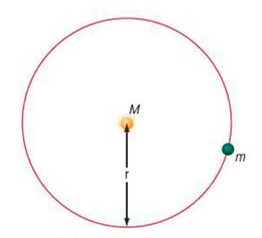
⇒ In this image, a planet of mass, m, is in a circular orbit around a star of mass, M
⇒ Now we can combine the equations of circular motion and gravitation to link the speed or time period of a planet's orbit to its distance from the sun
⇒ The pull of gravity provides the necessary centripetal force to keep the planet in orbit. So we can write:
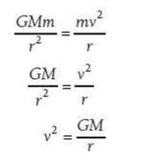
⇒ From this, you can see that the speed of the orbit is faster for small orbits
⇒ The following graph shows the link between orbital speed and the distance of our 8 planets from ths sun
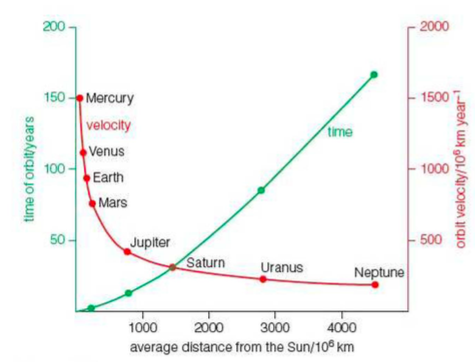
⇒ We can also link the time period of the orbit (1 year for Earth) to the radius of the orbit
⇒ The speed of the orbit is linked to the circumference, 2πr, and the time period of the orbit, T, through the equation:
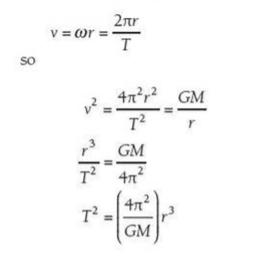
⇒ The above graph also shows the relationship between time period and orbital radius of the planet
Elliptical Orbits
⇒ In the previous section, we treated all orbits as if they were circular - this is because it is relatively easy to cope with the maths of circular orbits
⇒ In practice, very few orbits are circular - most orbits have an elliptical shape
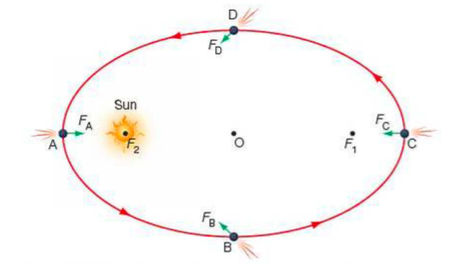
⇒ This shows a possible elliptical orbit for a comet (black dot) travelling round the sun
⇒ Most planetary orbits are nearly circular
- For example, the Earth's closest approach to the sun (perihelion) is 147 x 106km and its furthest distance (aphelion) is 152 x 106km
⇒ However, comets and some minor planets have elongated (or eccentric) elliptical orbits
⇒ You should note that the relationship derived in the last section linking the time period of an orbit to the radius of the orbit is still valid for elliptical orbits, provided r is taken to be half the major axis of the ellipse
- The major axis in the image above is the distance AC, and the minor axis is the distance BD
- So, for elliptical orbits we can write:

⇒ When a planet or comet moves in an elliptical orbit, its speed changes but the total energy of the body stays the same
⇒ At point A, the comet is moving at its fastest orbital speed, but its smallest gravitational potential energy, because it is closest to the sun
⇒ At point B, there is a component of the sun's gravitational pull on the comet, which slows it down
⇒ When the comet reaches point C, it is at its furthest point from the sun. It has its lowest kinetic energy at this point, but its highest gravitational potential energy
⇒ At point D, the comet is falling back towards the sun. There is a component of the sun's gravitational pull, which speeds it up. The comet's potential energy is being transferred into kinetic energy, and the comet reaches its maximum speed again at A
Satellite Orbits
⇒ There are many satellites in orbit round the Earth, which are used for a range of purposes.
⇒ Two of the most common uses of satellites are communications and observations
⇒ Satellites placed in lower orbits are able to take photographs of the world below.
- We are used to seeing images of mountain ranges, lakes and cities taken from space, and we use weather images on a daily basis
⇒ Satellites used in higher orbits are useful for communications, because messages may be sent from one part of the world to another
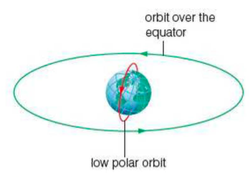
⇒ One of the most useful orbits for satellites is the geosynchronous orbit
- In this case the satellite is placed in an orbit above the Earth's equator at such a position it takes exactly one day to orbit the Earth
- The orbit is synchronised with the Earth's rotation, so that it remains in the same place above the Earth's surface
- This means that our satellite dishes, for example, can be aligned with a satellite, which always lies in the same position relative to Earth
Example


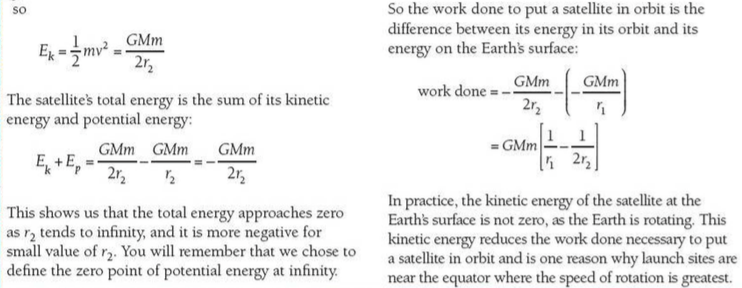
Extra
⇒ Also see our notes on: